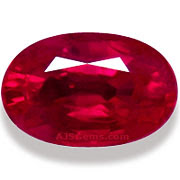Mogoke is a city (population 150,000) in the Mandalay Division of Myanmar, located 200 km north of Mandalay and 148 km north-east of Shwebo. At 1170 meters in elevation, the city has fairly temperate climate year-round, and is home to mostly Bamar, with large minorities of Shan, Lisu, Palaung, Karen ethnic groups, as well as Chinese, Indians and Nepali.
Mogoke has been famous since ancient times for its gemstones, especially ruby and sapphire, but semi-precious stones such as lapis lazuli, garnet, moonstone, peridot and chrysoberyl are also found. The gems are found in alluvial limestone gravels by means on panning, tunneling and digging pits by hand. There is little mechanization of the mining.
Gems are sold in markets in Mogoke; however, foreigners require special permits to visit the town, and purchase/export of gems from Myanmar at non-government licensed dealers is illegal.
Mogoke is a suitable place to live every people.
Rubies - The King of Gemstones
The ruby is a gem of the multi-coloured corundum family - the second hardest natural mineral known to man.All through the ages, the ruby with its magnificent color, outstanding brilliance, hardness and extreme rarity has made it one of the most valuable gemstones on Earth.
Corundum, whose name comes from the Hindi kurund and the Sanskrit kurunwinda, is formed of crystallized aluminum and oxygen. In its pure form it is white or colourless - only the red corundum is called a ruby. All other colors are named sapphires, with hues of orange, pink, blue and green. Tiny amounts of chromium oxide is the element, which gives the ruby its intense and magnificent color.
Color
The red of a ruby may have various nuances depending on its origin. When reference is made to the very top category it is often "a Burmese ruby" - an indication that it is a rich, passionate, hot, full red color with a slightly bluish hue. Sometimes it is referred to as "pigeon blood red" a ruby color only associated with the Mogok valley mines.The color of a ruby is the most important feature of the stone. The color of a Burmese ruby is regarded as exceptional, with a display of unique luster in any light.
Clarity
It is typical of rubies to display inclusions of other crystal habits. Frequently these are hexagonal prisms and blades. If they are rutile needles, they may form a delicate shimmer of light known as "silk". The same inclusions prove conclusively that a ruby is natural and not man-made.Inclusions within a ruby are actually nature's own "fingerprint" in each stone - a statement of its individuality and its proof of natural origin. So unless they are of a character, which badly decreases the transparency of the stone, the overall quality of the ruby is not impaired.
Cut
The make or the cut is man's contribution to the beauty of the ruby and indeed to the value of the ruby.Only the professional and expert stone cutter is able to determine the best way to display the inherent beauty of the stone without losing too much valuable weight in the process. The expertise of the Burmese cutters is legendary in this respect.
Very seldom do rubies grow into large crystals. Stones of more than 3 carats in size are very rare.
Symmetry, good proportions, precise faceting and angles are all features which the expert stone cutter aims to adhere to, embracing the final intensity, beauty and value of the ruby.
..and a little Ruby Metaphysic.
A ruby is often associated with strong leadership, self-confidence, skills of negotiation and self-esteem. And a ruby brings wealth, good health and wisdom to its owner.Ruby is birth stone for July.








.jpg)
Mogoke's Sappire





Green Apatite
Purple Apatite


Green Garnet
Spessartite Garnet
Spinel
Mogok Moonstone

Peridot

Tourmaline var Vanadium Uvite (Verdelite)


































